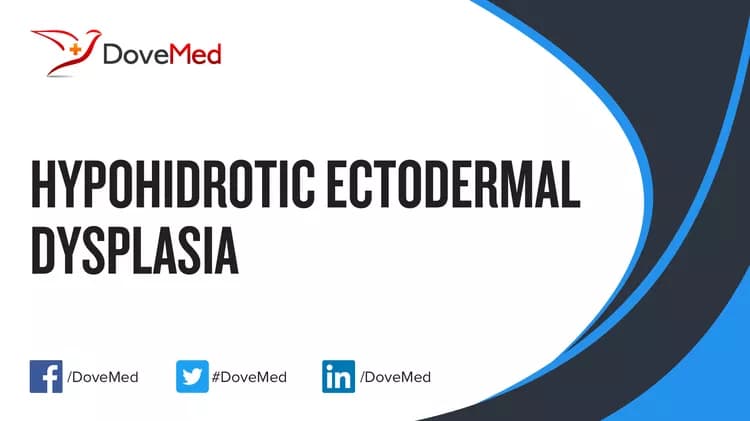What are the other Names for this Condition? (Also known as/Synonyms)
- Christ-Siemens-Touraine Syndrome
- EDA (Ectodermal Dysplasia Anhidrotic)
- X-Linked Hypohidrotic Ectodermal Dysplasia (XLHED)
What is Hypohidrotic Ectodermal Dysplasia? (Definition/Background Information)
- Hypohidrotic Ectodermal Dysplasia (HED) may be described as an uncommon and hereditary skin disorder that manifests as decreased sweating ability, tooth loss, and minimal body and scalp hair
- The treatment for the condition involves the use of hair care products, lifestyle changes to maintain body temperature, and surgical corrections of oral or facial defects, as needed
- The prognosis of Hypohidrotic Ectodermal Dysplasia is determined on a case-by-case basis, but HED is a lifelong condition that can present significant complications
Who gets Hypohidrotic Ectodermal Dysplasia? (Age and Sex Distribution)
- Hypohidrotic Ectodermal Dysplasia is a rare congenital disorder. The presentation of symptoms may occur at birth
- Both males and females may be affected. However, when the condition occurs in an X-linked manner, males are predominantly affected
- Worldwide, individuals of all racial and ethnic groups may be affected
What are the Risk Factors for Hypohidrotic Ectodermal Dysplasia? (Predisposing Factors)
- A positive family history may be an important risk factor, since Hypohidrotic Ectodermal Dysplasia (HED) can be inherited
- Currently, no other risk factors have been clearly identified for HED
It is important to note that having a risk factor does not mean that one will get the condition. A risk factor increases one’s chances of getting a condition compared to an individual without the risk factors. Some risk factors are more important than others.
Also, not having a risk factor does not mean that an individual will not get the condition. It is always important to discuss the effect of risk factors with your healthcare provider.
What are the Causes of Hypohidrotic Ectodermal Dysplasia? (Etiology)
- Hypohidrotic Ectodermal Dysplasia (HED) is caused by genetic abnormalities which are passed down (through families) in the following manner:
- Autosomal dominant - termed Autosomal Dominant Hypohidrotic Ectodermal Dysplasia (ADHED)
- Autosomal recessive - termed Autosomal Recessive Hypohidrotic Ectodermal Dysplasia (ARHED)
- X-linked manner, which is the most commonly occurring form - termed X-Linked Hypohidrotic Ectodermal Dysplasia (XLHED)
- It is caused by mutations in several genes that include:
- EDA gene: Defects in the EDA gene cause inactive ectodysplastin A1 (EDA1)
- EDAR gene
- EDARADD gene
Ectodermal dysplasias are a group of hereditary genetic disorders involving the ectodermal tissues, such as the skin (sweat glands), nails, hair, and teeth, resulting in mild or severe abnormalities. In HED, eccrine sweat glands, teeth, and hair follicles show abnormal development.
Autosomal dominant: Autosomal dominant conditions are traits or disorders that are present when only one copy of the mutation is inherited on a non-sex chromosome. In these types of conditions, the individual has one normal copy and one mutant copy of the gene. The abnormal gene dominates, masking the effects of the correctly function gene. If an individual has an autosomal dominant condition, the chance of passing the abnormal gene on to their offspring is 50%. Children, who do not inherit the abnormal gene, will not develop the condition, or pass it on to their offspring.
Autosomal recessive: Autosomal recessive conditions are traits or disorders that occur when two copies of an abnormal gene have been inherited on a non-sex chromosome. If both parents have an autosomal recessive condition, there is a 100% likelihood of passing on the mutated genes to their children. If, however, only one mutant copy of the gene is inherited, the individual will be a carrier of the condition, but will not be present with any symptoms. Children born to two carriers, have a 25% chance of being homozygous dominant (unaffected), a 50% chance of being heterozygous (carrier), and a 25% chance of being homozygous recessive (affected).
X-linked inheritance: A condition is considered X-linked if the mutated gene that causes the disorder is located on the X chromosome, one of the two sex chromosomes. In males (who have only one X chromosome), one altered copy of the gene in each cell is sufficient to cause the condition. In females (who have two X chromosomes), a mutation must be present in both copies of the gene to cause the disorder. Males are affected by X-linked recessive disorders much more frequently than females. A characteristic of X-linked inheritance is that fathers cannot pass X-linked traits to their sons.
What are the Signs and Symptoms of Hypohidrotic Ectodermal Dysplasia?
The signs and symptoms associated with Hypohidrotic Ectodermal Dysplasia (HED) may vary in severity from one individual to another. It is reported that individuals with the autosomal dominant form of HED present the mildest signs and symptoms.
The most common signs and symptoms include:
- Sparse body and scalp hair; dry scaly skin
- Decreased ability to sweat
- Missing teeth
- Cleft palate
- Respiratory illnesses
How is Hypohidrotic Ectodermal Dysplasia Diagnosed?
The diagnosis of Hypohidrotic Ectodermal Dysplasia (HED) may involve the following tests and procedures:
- A complete evaluation of the family medical history along with a thorough examination of the child (affected individual). In many cases, a healthcare provider may suspect HED based on his/her clinical assessment
- The healthcare provider may also ask many questions related to the individual’s age, family medical history, current medications, cosmetics, body lotions used, other medical conditions, infections, etc.
- Dermoscopy: It is a diagnostic tool where a dermatologist examines the skin using a special magnified lens
- Wood’s lamp examination: In this procedure, the healthcare provider examines the skin using ultraviolet light. It is performed to examine the change in skin pigmentation
- Prenatal tests, if required
- Molecular genetic testing to identify the gene involved
- Skin biopsy: A skin tissue biopsy is performed and sent to a laboratory for a pathological examination. The pathologist examines the biopsy under a microscope. After putting together clinical findings, special studies on tissues (if needed) and with microscope findings, the pathologist arrives at a definitive diagnosis
Many clinical conditions may have similar signs and symptoms. Your healthcare provider may perform additional tests to rule out other clinical conditions to arrive at a definitive diagnosis.
What are the possible Complications of Hypohidrotic Ectodermal Dysplasia?
The complications of Hypohidrotic Ectodermal Dysplasia may include:
- Overheating of the body, especially in warm-hot outdoors - heat intolerance
- Facial deformity
- Dental abnormalities: absence of teeth, or small teeth
- Total or partial absence of scalp hair
- Speech impairment
- Asthma
- Emotional stress due to cosmetic concerns
- Social isolation
- Reduced quality of life if the condition is severe
Complications may occur with or without treatment, and in some cases, due to treatment also.
How is Hypohidrotic Ectodermal Dysplasia Treated?
There is no cure for Hypohidrotic Ectodermal Dysplasia. The condition is managed by treating the various symptoms and may involve the following measures.
- Lifestyle modifications:
- Staying in cool weather and air-conditioned spaces (at home/school); wearing cool clothing
- Take plenty of cool fluids to maintain body temperature
- Artificial tears may be used in individuals who do not produce sufficient tears
- Use of dentures and dental implants, surgical correction of teeth defects. This includes the need for dentures in childhood, with new prostheses needed as the child grows
- Cleft palate surgical repair
- Hair care lotions and use of wigs
Regular medical screening at periodic intervals with tests and physical examinations are recommended.
The following treatments are being studied/investigated:
- Studies in newborn dogs with X-Linked HED showed intravenous recombinant canine ectodysplastin A1 triggered a partial improvement of teeth, sweat glands and hair follicles
- Further studies showed that injection of normal canine ectodysplastin A1 prenatally, into the amniotic fluid, showed significant improvement of hair and sweat gland equivalents
- Three male human patients were treated with post-birth injections with recombinant (normal) ectodysplastin A1, and six males were treated with intrauterine amniotic fluid injection of ectodysplastin A1 beginning at 26 weeks of gestation
- Short term and long term results have shown significant improvement
FDA Breakthrough Therapy Designation has been granted for this treatment. The investigational treatment is designated ER-004.
How can Hypohidrotic Ectodermal Dysplasia be Prevented?
Currently, Hypohidrotic Ectodermal Dysplasia may not be preventable since it is a genetic disorder.
- Genetic testing of the expecting parents (and related family members) and prenatal diagnosis (molecular testing of the fetus during pregnancy) may help in understanding the risks better during pregnancy
- If there is a family history of the condition, then genetic counseling will help assess risks, before planning for a child
- Active research is currently being performed to explore the possibilities for treatment and prevention of inherited and acquired genetic disorders
What is the Prognosis of Hypohidrotic Ectodermal Dysplasia? (Outcomes/Resolutions)
- The prognosis of Hypohidrotic Ectodermal Dysplasia is dependent upon the severity of the signs and symptoms and associated complications, if any
- Individuals with mild conditions have better prognosis than those with severe symptoms and complications. Typically, the prognosis may be assessed on a case-by-case basis but is mostly good
Additional and Relevant Useful Information for Hypohidrotic Ectodermal Dysplasia:
The following DoveMed website link is a useful resource for additional information:
Related Articles
Test Your Knowledge
Asked by users
Related Centers
Related Specialties
Related Physicians
Related Procedures
Related Resources
Join DoveHubs
and connect with fellow professionals



0 Comments
Please log in to post a comment.